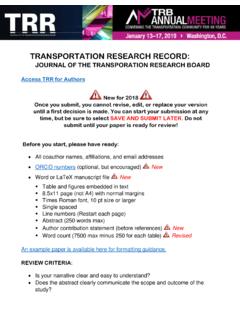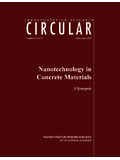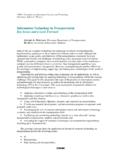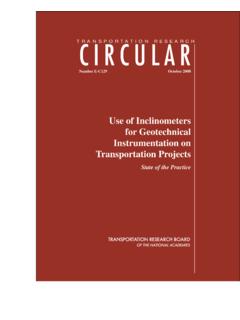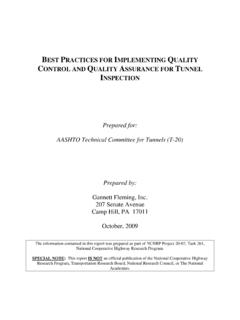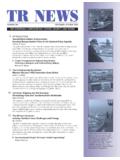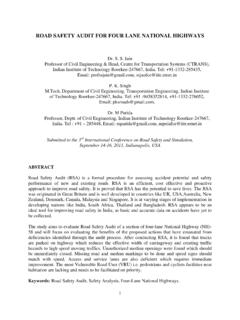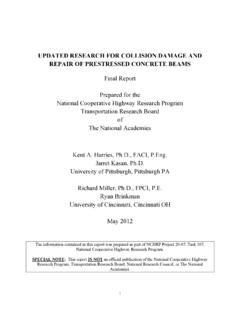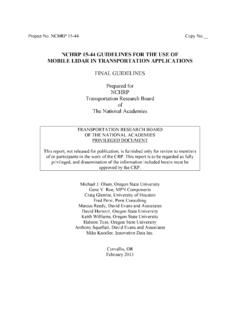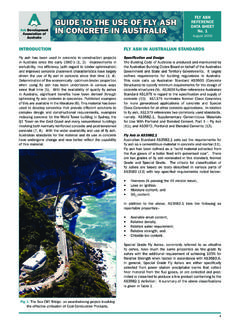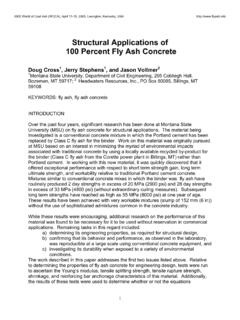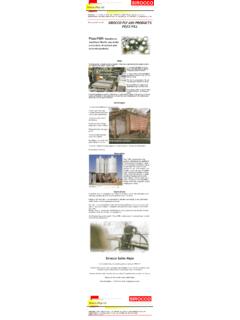Transcription of Cementitious Stabilization - Transportation Research Board
1 A2J01: Committee on Cementitious StabilizationChairman: Roger K. Seals, Louisiana State UniversityCementitious StabilizationDALLAS N. LITTLE, Texas A&M UniversityERIC H. MALES, National Lime AssociationJAN R. PRUSINSKI, Portland Cement AssociationBARRY STEWART, American Coal Ash AssociationThe principal materials used for the Cementitious Stabilization and modification of highwaypavement materials are lime, fly ash, and portland cement. Whereas lime and portlandcement are manufactured products, fly ash is a by-product of the burning of coal at electricpower generating stations. As a consequence, fly ash generally exhibits greater variabilitythan is seen in the other products.
2 By-products such as kiln dust and fluidized bed ash fromvarious manufacturing and energy generating processes are used to a lesser extent. Whileall of these products and by-products are used for similar purposes, different testing,design, construction, and quality assurance/quality control (QA/QC) methodologies havebeen developed for projects are almost always site-specific, requiring the application ofstandard test methods, along with fundamental analysis and design procedures, to developan acceptable solution. As with any such process, adherence to strict environmentalconstraints is vital to project success.
3 The use of Cementitious materials makes a positivecontribution to economic and resource sustainability because it allows enhancement ofboth standard and substandard in situ soils to levels consistent with the requirements of agiven STABILIZATIONLime Stabilization is a widely used means of chemically transforming unstable soils intostructurally sound construction foundations. Lime Stabilization is particularly important inroad construction for modifying subgrade soils, subbase materials, and base materials. Theimproved engineering characteristics of lime-treated materials provide important benefitsto both portland cement concrete (rigid) and asphalt (flexible) Stabilization creates a number of important engineering properties in soils,including improved strength; improved resistance to fracture, fatigue, and permanentdeformation; improved resilient properties; reduced swelling; and resistance to thedamaging effects of moisture.
4 The most substantial improvements in these properties areseen in moderately to highly plastic soils, such as heavy clays. Although lime is generallyused to transform fine-grained soils permanently, it may be used for shorter-term soilmodification for example, to provide a working platform at a construction MechanismsSoil lime reactions are complex; however, understanding of the chemistry involved andresults of field experience are sufficient to provide design guidelines for successful limeTransportation in the New Millennium2treatment of a range of soils. The sustained (and relatively slow) pozzolanic reactionbetween lime and soil silica and soil alumina (released in the high-pH environment) is keyto effective and durable Stabilization in lime soil mixtures.
5 Mixture design procedures thatsecure this reaction must be addition to stabilizing materials, lime plays an increasing role in the reclamation ofroad bases. Lime has been used effectively to upgrade or reclaim not only clay soils, butalso clay-contaminated aggregate bases and even calcareous bases that have little or noappreciable clay. Work in the United States, South Africa, and France has established thebenefits of lime Stabilization of calcareous bases. The process results in significantimprovements in strength, moisture resistance, and resilient modulus without transformingthe calcareous bases into rigid systems that could be susceptible to cracking and Design, Pavement Design, and Performance ConsiderationsDesign of lime-stabilized mixtures is usually based on laboratory analysis of desiredengineering properties.
6 Several approaches to mix design currently exist. In addition toengineering design criteria, users must consider whether the laboratory procedures usedadequately simulate field conditions and long-term performance. Aspects of theseprocedures are likely to be superceded as the American Association of State Highway andTransportation Officials (AASHTO) shifts to a mechanistic-empirical testing procedures include determining optimum lime requirements andmoisture content, preparing samples, and curing the samples under simulated fieldconditions. Curing is important for chemically stabilized soils and aggregates particularlylime-stabilized soils because lime soil reactions are time and temperature dependent andcontinue for long periods of time (even years).
7 Pozzolanic reactions are slower thancement-hydration reactions and can result in construction and performance benefits, suchas extended mixing times in heavy clays (more intimate mixing) and autogenous healing ofmoderately damaged layers, even after years of service. On the other hand, longer reactionsmay mean that traffic delays are associated with using the pavement. In addition, protocolsfor lime soil mixture design must address the impact of moisture on Stabilization construction is relatively straightforward. In-place mixing (to theappropriate depth) is usually employed to add the proper amount of lime to a soil, mixed toan appropriate depth.
8 Pulverization and mixing are used to combine the lime and soilthoroughly. For heavy clays, preliminary mixing may be followed by 24 to 48 hours (ormore) of moist curing prior to final mixing. This ability to mellow the soil for extendedperiods and then remix is unique to lime. During this process, a more intimate mixing ofthe lime and the heavy clay occurs, resulting in more complete Stabilization . For maximumdevelopment of strength and durability, proper compaction is necessary; proper curing isalso important. Other methods of lime Stabilization include in-plant mixing and GapsThe performance of lime-stabilized subbases and bases has been somewhat difficult toassess in the current AASHTO design protocol because the measure of structuralcontribution the structural layer coefficient cannot be ascertained directly.
9 Indirectlydetermined coefficients for lime-stabilized systems, however, have been found to bestructurally significant. As AASHTO shifts to a mechanistic-empirical approach,measurable properties, such as resilient moduli, will be used to assess stress and straindistributions in pavement systems, including stabilized bases and subbases. TheseCementitious Stabilization3properties will be coupled with shear strength properties in assessing resistance toaccumulated lime industry has submitted a three- to four-step design and testing protocol to beconsidered for inclusion in the AASHTO design protocol: Step 1 Determine optimum lime content using the Eades and Grim pH test.
10 Step 2 Simulate field conditions. Use AASHTO T-180 compaction and 7-daycuring at 40 C to represent good-quality construction techniques. After curing, subjectsamples to 24 to 48 hours of moisture conditioning. Step 3 Verify compressive strength, stiffness, and moisture sensitivity. Measureunconfined compressive strengths using ASTM D-5102 most applications, the above three steps are sufficient because design parameterssuch as flexural strength, deformation potential, and stiffness (resilient modulus) can beapproximated from unconfined compressive strength. For more detailed (Level 2) designs,a direct measure of resilient modulus may be required: Step 4 Perform resilient modulus testing using AASHTO T-294-94 or expedited(and validated) alternatives, such as the rapid triaxial protocol and its mechanistic-empirical basis provide a sound foundation for futurelime- Stabilization applications.
